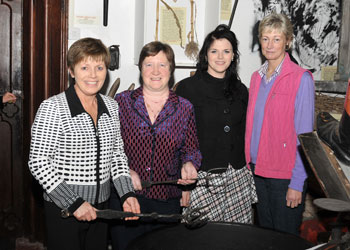It was on the 15th November 1996 that the Minute Book of the Thurles /Rahealty Famine Food Committee was first discovered in St. Mary’s Church Thurles Co. Tipperary. The book had been put in an old apple box with some unwanted prayer and hymn books in 1850 and then placed on the top floor in the bell tower for safe keeping. Over the next 146 years the 2nd and 3rd floors leading to the 4th floor bell tower became unsafe and the contents of the apple box were forgotten. Then in 1996 it was decided to fully restore the church and its 13th century tower resulting in the box and its contents being located and identified.
This minute book contains valuable information of both local & national importance, concerning the ‘Great Famine’ period 1846 and 1847.
In this book the locations of the soup kitchens in Thurles are given, together with details of their running costs and those employed there.
On Sunday next 15th November for the first time since 1849 a group of ladies from this parish Church will make history by manufacturing this soup, based solely on the recipe contained in these historical minutes.
Visitors to the Church on Sunday next from 10.00am until 6.00pm can view the large collection of famine memorabilia contained in the Famine Museum and if they wish can also taste, for the first time, this famine soup which was given, mainly free, to those forced to attend the 3 soup kitchens then established here in Thurles during the 1845 to 1849 period.
All tours on the day will be accompanied by a guide.
This event will be followed later in the evening by the second annual Famine Memorial multi denomination service which will take place in St. Mary’s Church also on Sunday next, 15th November at 8.00 pm. This ceremony will be conducted by the Rector of St. Mary’s, Rev Peter Cole-Baker assisted by local historian Rev. Monsignor Dr. Maurice Dooley, latter retired parish priest of Loughmore, who will also preach the sermon. Music for this famine memorial service will be provided by members and musicians of the Thurles Cathedral Youth Choir and Phoenix Productions under the direction of local Councillor & Solicitor Mr. Gerard O’Brien.
A warm invitation is issued to all who wish to attend any part of this full day event on Sunday next and elderly persons are advised to come early for the memorial service to ensure seating.
Front and rear gates to St. Mary’s Church will be open, to allow for easy access and car parking.


Hello, hope you are well, my reply is a question.
I’m fairly new to Irish history so bear with me, I’m aware that there were potato blights every few years,and that by 1845 the land had been sub-divided and sub-divided so much by the British that the only crop that could be grown to sustain the people was the potato, it was at the bottom of the crop chain, the british had been exporting food (including live stock) under armed guard,out of Ireland, that ONE POINT SIX MILLION PEOPLE STARVED TO DEATH, I recently read that the exported food was enough to feed those people one and a half times! So,my question is :- Why is it still refered to as “A FAMINE” or “THE GREAT FAMINE, the British used that blight to obtain their centuries old goal,to get the Irish into the ground, and they nearly succeeded,
Hi Michael,
I will answer your question with a series of questions.
Who sold the live stock to the British during the great famine to remove in the first place?
If, during the Famine, you had a cow for sale and an Irish buyer offers you £5, while the British buyer offered £6, in all honesty to whom would you sell?
Famine has got nothing to do with lack of food; if it had then we would never have a famine, since we grow 6 times more food in this world than is needed to feed the whole world twice over. Famine is caused by lack of money with which to buy food.
Armed guards were protecting the goods bought and paid for by the British. Why do armed soldiers today guard trucks transporting money from bank to bank at the tax payers expence?
The potato was not at the bottom of the food chain. The potato most used during the famine was a variety called the “Lumper”. It has all of the vitimins required for human living except one, Vitimin A. This potato contains Vitamin C 45%, Thiamin 10%, Niacin 8%, Vitamin B6 14%, Folacin 14%, Panthothenic Acid 6%, Phosphorous 6%, Magnesium 12%,and Iron 9%. Vitamin A was gotten from buttermilk, hence , Potatoes and Buttermilk.
The blight first appeared in Ireland on the 15 August 1845 and not before.
Previous potato famines lasted only one year, usually caused by severe weather conditions like frost.
Pure greed, laziness and the unwillingness to share with each other causes famine and poverty.
Look at the state of Ireland today. Pity our teachers do not teach this subject in more depth in our schools.
I was back there from America and visited the Church and had the famine soup. It was the first time I was in that Church and was very impressed.